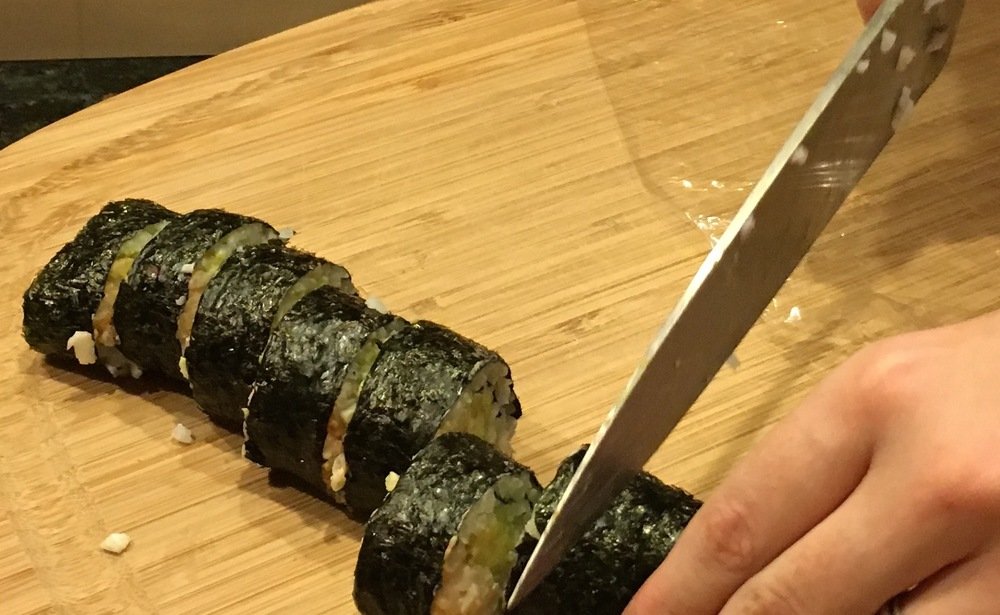Making Maki
Photo by Diane M. Dresback
For most of my life, I refused to eat sushi. The thought of raw fish turned my stomach. Cooked fish — well, some cooked fish proved enjoyable. But the uncooked variety? No way.
I’m not sure where I developed my disdain for consuming raw fish. Likely from watching too many movies where a starving character in the wilderness plucks some unsuspecting Salmon, minding his own business while making his up-stream journey, and takes an enormous bloody bite from its flesh as the slimy creature wriggles wildly.
So my life without sushi went on. Until about six years ago.
While at the Asian Kitchen in Mesa, Arizona, my oldest son convinced me to try a piece of his “safe” and “un-fishy” smelling Philly roll. Hesitant, but attempting to model bravery, I obliged. The Philly roll consisted of smoked salmon, cream cheese and cucumber. How can you go wrong with anything with cream cheese in it?
I was beyond surprised to find it delicious!
My next experience came with a group of filmmaking friends celebrating the upcoming screening of our feature film - Atrophy. We wandered into Sapporo in Scottsdale, Arizona. Several different types of rolls were ordered that we could all share. But my heart became set on only consuming one once I tasted the Tootsie roll made with crab mix, cucumber, tempura flakes and Eel sauce.
I began kicking myself for all the decades that had passed me by without taking pleasure in the Japanese cuisine.
Over the past few years, I’ve indulged in different kinds of sushi, but retain a sort of conservativeness with my tastes. A chunk of cool raw fish on top of rice is a bit more than my mouth’s texture-sensors can handle, so I avoid Nigiri style sushi.
The crazy question I continue to ask when trying something new, “Is it fishy?” may seem a bit ridiculous. I like fish that isn’t overly fishy tasting. But there are a lot of sushi rolls that are more mild, plus it’s not all raw. The combination of the ingredients is what makes the rolls so delectable - Salmon, Spicy Tuna, California, Tempura Shrimp. For those that just can’t get themselves to stomach the fish can opt for Avocado or Veggie rolls.
I remember a place that my son took me to in Austin, Texas called Tomodachi Sushi. His favorite was called the Ex-Girlfriend roll - crab, avocado, spicy tuna with halibut tempura and spicy mayo. Not sure if the original maker had a bad breakup with his girl or what, but it was yummy nonetheless.
Over the holidays, Rick and I met with some of our children in Cornville, Arizona for a few days. As usual with our family get-togethers, we do a lot of cooking. One night my oldest son and his wife taught us how to make homemade sushi.
Photo by Diane M. Dresback
We each prepared our own by starting with Nori — a thin flexible green sheet of edible dried seaweed. We topped the Nori with a layer of Pearl Rice which is small grain white rice with rice vinegar, sugar and salt added to make it nice and sticky.
My son shared some sushi trivia that is quite interesting.
The sushi we were making with the rice on the inside and the Nori on the outside is technically called Maki. But often restaurants here in the States hide the seaweed from us American’s by placing the rice outside of the Nori. This is called Uramaki.
In Japan, Uramaki is rare because in that country sushi is eaten with your fingers and with sticky rice that can create quite the mess. That’s why some high end sushi places will tell people that it's perfectly fine and polite to eat sushi with your fingers instead of chopsticks.
Okay back to our Maki making. Next came about an inch wide strip of sliced cucumbers, avocado, some crab mix (purchased in a prepared state), and a splash of spicy mayo. Alright so the crab mix was imitation, but it was made of pulverized white fish. Apparently most sushi crab in America is made that way due to the high cost of actual crab. My son mixed the “crab” with mayo, vinegar and salt.
Photo by Diane M. Dresback
Then we rolled the Nori up tightly — sort of like rolling a sleeping bag, and sliced it into bite-sized chunks.
From there we drizzled a homemade Unagi sauce that my daughter-in-law had prepared. It’s more commonly known as an Eel Sauce although it contained no actual Eel. Cooked with a blend of saki, murin, sugar and soy sauce, it possessed a wonderfully sweet, salty taste.
Finally we sprinkled Panko on top which is Japanese-style breadcrumbs made from white bread without the crust. This offered a light, airy texture adding a crunchy sensation to every bite.
I must admit, our homemade Maki was every bit as savorous if not better than anything I’ve purchased in a restaurant!
Photo by Diane M.. Dresback
There are so many different types of sushi out there. I’m not an expert by any means and am still quite tame with my choices. But eating sushi has definitely become an experience that I look forward to once in awhile. It’s well worth a try if you’ve never given it a go.
Although after all that good vacation eating, I’m now back in Austin eating celery and carrots sticks!
If you know others who would enjoy these thoughts, share this Blog with this easy link: Making Maki
You can stay up on the progress of my novel and filmmaking escapades and receive a free book by subscribing to my Newsletter.
Find details about my books at dianedresback.com and my filmmaking at mindclover.com.



